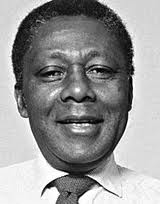Le Pauvre de Bomba; Main Basse Sur le Cameroon: Difference between revisions
No edit summary |
No edit summary |
||
| Line 8: | Line 8: | ||
---- | ---- | ||
[[File:Beti.jpg|left]] | [[File:Beti.jpg|left]] | ||
'''Artist:''' Mongo Beti | '''Artist:''' Mongo Beti (1932 - 2001) | ||
'''Confronting Bodies:''' French and Cameroonian governments, Catholic Church officials | '''Confronting Bodies:''' French and Cameroonian governments, Catholic Church officials | ||
Latest revision as of 19:48, 7 February 2012
Date: 1956 1972
Region: Africa Europe
Subject: Political/Economic/Social Opinion Religious
Medium: Print Journalism Literature
Artist: Mongo Beti (1932 - 2001)
Confronting Bodies: French and Cameroonian governments, Catholic Church officials
Dates of Action: 1956, 1972
Location: Cameroon, France
Description of Artwork: Beti is considered a radical by church and government officials in France and Cameroon. His work harshly criticizes the political relationship between France and Cameroon.
The Incident: In 1956 Cameroonian colonial authorities and Catholic Church officials banned Beti's Le Pauvre de Bomba (The Poor Bomba) A single copy was allowed to remain at the University of Yaounde. Beti moved to France and wrote Main Basse Sur le Cameroon (Grabbing Cameroon), which was also banned and confiscated by the French and Cameroonian governments. When he returned to Cameroon in 1993 he was refused permission to run for legislative elections.
Results of Incident: "Main Basse Sur le Cameroon" sold 20,000 copies in other countries and inspired Amnesty International to produce a film entitled "Anti-censorship." Beti was invited to speak at numerous foreign universities.
Source: Censorship, A World Encyclopedia, ed. D. Jones
